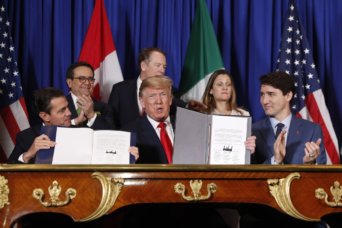- About
- Topics
- Picks
- Audio
- Story
- In-Depth
- Opinion
- News
- Donate
- Signup for our newsletterOur Editors' Best Picks.Send
Read, Debate: Engage.
| topic: | Economic Opportunity |
|---|---|
| located: | Mexico, Canada, USA |
| editor: | Magdalena Rojo |
The United States-Mexico-Canada Agreement (USMCA) is closer to enter into force. After the leaders of the three countries signed the deal in November 2018, it had to be ratified by the legislative bodies of each state. Mexico ratified the agreement in June this year. However, the House of Representatives in the US demanded the revision of certain parts of the document, mostly in terms of stricter environmental protection and labour provisions.
After the changes were made, the revised document was signed by all parties again this December. The House passed the deal earlier this month causing a relief on the side of Mexico as well as president Trump, who called the former North American Free Trade Agreement (NAFTA) "the worst trade deal ever made". The next step is the ratification by the Senate that should be on the programme after the impeachment trial, presumably in January. Canada is waiting for the US Congress to ratify the agreement.
The upgraded version of NAFTA from 1994 touches various issues. One of the biggest changes is in regards to the automobile industry. To qualify for zero tariffs, automobiles must have 75 per cent of the components made in one of three countries (comparing to 62.5 before). Furthermore, 40 to 45 per cent of automotive parts must be made by workers who earn at least $16 per hour by 2023, which will ensure manufacture in the US where the wages are higher than in Mexico.
Mexican president Andrés Manuel López Obrador already assured US lawmakers that the minimum wage in Mexico would increase each year by at least 2% above inflation. Mexico also agreed to pass new labour laws, which was a demand by Democrats in the House. To reach ratification, the Mexican government promoted a labour reform this year to improve the conditions of workers. The enforcement of labour provisions caused a dispute between Mexico and the US when the latter suggested controls of labour rights in Mexico by US experts without consulting the Mexican side.
New rules should also apply for intellectual property and digital trade, which were not a part of NAFTA. The chapter on the environment includes commitment to protect marine life and prevent and reduce marine litter; articles to improve air quality, support sustainable forest management, and ensure appropriate procedures for environmental impact assessments.
Furthermore, US dairy farmers will get more access to the Canadian market. The agreement also regulates control over biological drugs. It expires after 16 years and will be revised every six years.
At the moment, it is not clear when the agreement will come into effect. However, all sides felt the revision of NAFTA was necessary, as the times have changed. Moreover, Mexico has become the biggest trade partner for the US after the Washington-Beijing trade war.
